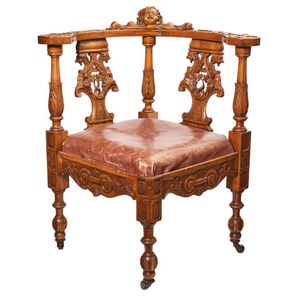19th Century Burr Walnut Card Table with Marquetry Inlay
You must be a subscriber, and be logged in to view price and dealer details.
Subscribe Now to view actual auction price for this item
When you subscribe, you have the option of setting the currency in which to display prices to $Au, $US, $NZ or Stg.
- Burr - Burr (or in the USA, burl) is the timber from the knotted roots or deformed branch of the tree, which when cut, displays the small circular knots in various gradations of colour. It is always cut into a decorative veneer, most commonly seen as burr walnut on 19th century furniture.
- Inlay - Decorative patterns inserted into the main body of a piece of furniture, generally in wood of contrasting colour and grain, though brass, ivory, ebony, shell and sometimes horn have been used. Inlay may consist of a panel of well figured timber inset into a cabinet door front, geometric patterns, or complex and stylized designs of flowers, swags of foliage, fruits and other motifs. As a general rule, in pieces where the carcase is constructed in the solid, the inlay is relatively simple such as stringing, cross banding and herringbone banding. Where more elaborate and decorative work was required veneer was used. Inlay has been fashionable from at least the latter half of the 17th century, when a variety of elaborate forms were developed
- Marquetry - In marquetry inlay, contrasting woods, and other materials such as ivory, shell and metal are inlaid either as panels or in a single continuous sheet over the surface of the piece. The design may be straightforward, such as a shell pattern or a basket of flowers, or it may be infinitely complex, with swirling tendrils of leaves, flowers and foliage, such as one finds, for example, in the "seaweed" patterns on longcase clocks of the William and Mary and Queen Anne periods.
- Foldover - A term used when describing card, tea or games tables, where the top folds over onto itself when not in use. The interior surfaces that are exposed when the top is open may be polished (in the case of tea tables) or baized (for card or games tables).
This item has been included into following indexes:
Visually similar items

Games table Victorian, burr walnut top, with birdcage base, length 92 cm

A Continental Renaissance revival corner chair, 19th century, the curved back rest with applied putto head, beneath foliate carved splats, the seat covered in red leather upholstery, 70 cm high, 47 cm wide, 24 cm deep

Pair of William IV rosewood card tables, c. 1830, the rounded rectangular hinged tops opening to a red baize playing surface, raised on a column with acanthus leaf decoration, quatrefoil base with lion paw feet (2), height 92 cm depth 45 cm width 74 cm

Hall table: English Victorian mahogany half round table, 1880s. Height 73 cm, width 90 cm, depth 45 cm
